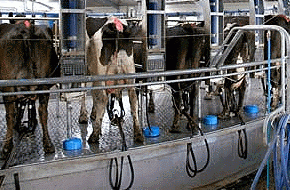
Content supplied by Rabobank

In its recently-released dairy seasonal update A hit for six in 2018/19 – New Zealand dairy farmers face a triple treat, agribusiness banking specialist Rabobank says New Zealand dairy farmers have enjoyed a period of profitability with milk prices above breakeven – and the upcoming season will see this run continue.
Rabobank forecasts a farmgate milk price of NZD 6.40/kgMS for the 2018/19 season.
Report author, dairy analyst Emma Higgins, says the 2018/19 season should be profitable for most New Zealand dairy farmers, despite greater uncertainty surrounding the operating environment than would usually be the case.
One of the global risks looming in the near term is the peak period of milk production in the northern hemisphere.
“The northern hemisphere flush will be an influential pressure point for commodity prices at the start of the 2018/19 season and we anticipate that supply will outstrip global demand in the coming months,” Ms Higgins said.
“However, as the second half of the 2018/19 season develops, Rabobank anticipates commodity prices will improve as production growth from key exporting regions decreases and a robust import program by Chinese buyers supports commodity prices across this period.”
Positive margins expected, but pressure points linger
The report says ample supply in key fertiliser markets continues to drive low global benchmark fertiliser prices, favouring New Zealand farmers and supporting strong farmer margins in the lead up to spring.
However, Ms Higgins says, while farmers should budget for affordable fertiliser prices over the application period, there is risk of some inflationary retail pressure.
“Rabobank anticipates rising ocean freight costs, combined with a weakening NZ dollar over the next 12 months will result is some upward pressure on fertiliser prices,” she said.
According to the report, another factor which may impact farmer margins in the 2018/19 season is upward pressure on interest rates.
The report says while the official cash rate is expected to remain steady over the coming 12 months, there is likely to be some upward pressure on commercial lending rates over the course of 2018 and farmers should plan accordingly.
Modest milk production growth
Assuming normal weather conditions, the report forecasts modest milk production growth of around two per cent for the 2018/19 season.
Ms Higgins says while milk production is expected to reboot after consecutive years of flat growth, a combination of environmental regulation, changes in PKE use, political uncertainty and increasing social pressures on farming practices will take the edge off exceptional milk growth in the new season.
“This forecast reflects the new era for New Zealand dairy, featuring greater utilisation of pasture and lower stocking rates.”
The report says while local feed is plentiful heading into winter, Fonterra’s new limits on Palm Kernel Extract (PKE) use by suppliers will be a factor behind modest production growth.
Ms Higgins says other feeds will need to fill the gap, particularly in the shoulders of the season or if, similar to the 2017/18 season, adverse weather devastates pastures in some areas.
“For the most part, farmers have prepared and adjusted their feed systems to meet the new requirements and will enter the new season in a position to cope with the changes. For those less prepared, it may take some time to switch feeds and adjust to the new requirements, resulting in higher feed costs,” she said.
After farmgate
A ‘big year’ is predicted for Fonterra, with the world’s largest dairy cooperative having some significant challenges ahead, including bedding down the new strategic partnership with a2 Milk Company and pressure to turn the Beingmate investment into a profitable partnership.
The report notes these challenges come at a time when dairy processors continue to compete for milk to retain and grow supply share, with new processing capacity coming on board ensuring stiff competition, particularly in parts of Waikato, and providing further options and opportunity for select farmers.
“At the same time, Fonterra needs to maintain the strong momentum in Australia to capitalise on the industry reset and to continue as its bright spot offshore. And while the search is ongoing, a new leader will be appointed to the helm to steer the cooperative through this turbulence,” Ms Higgins said.
The dairy payout history by company is here.




We welcome your comments below. If you are not already registered, please register to comment.
Remember we welcome robust, respectful and insightful debate. We don't welcome abusive or defamatory comments and will de-register those repeatedly making such comments. Our current comment policy is here.